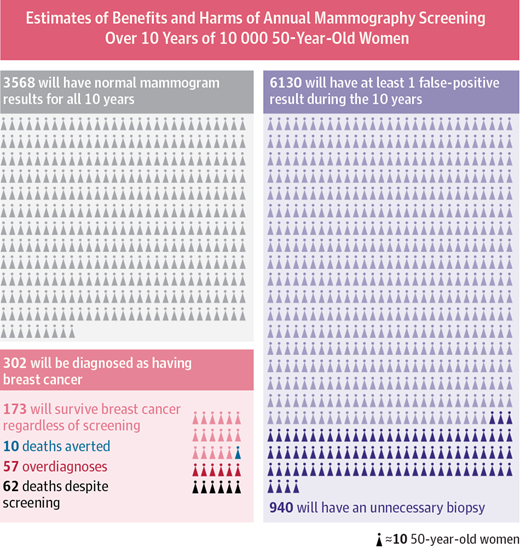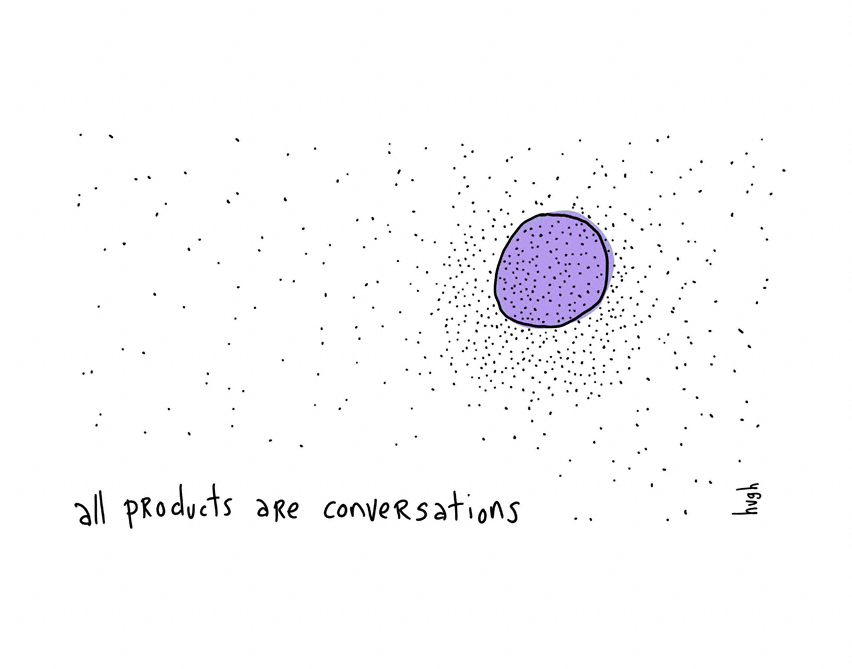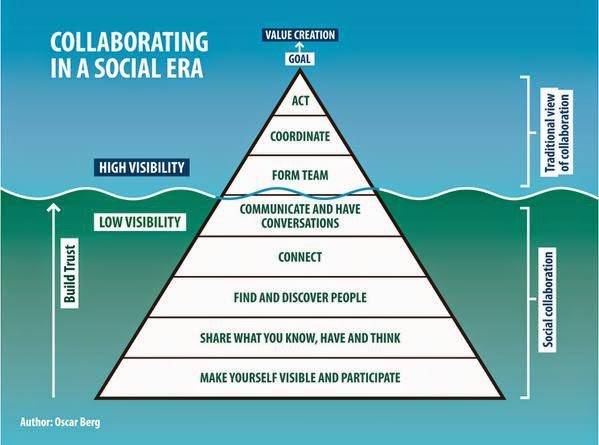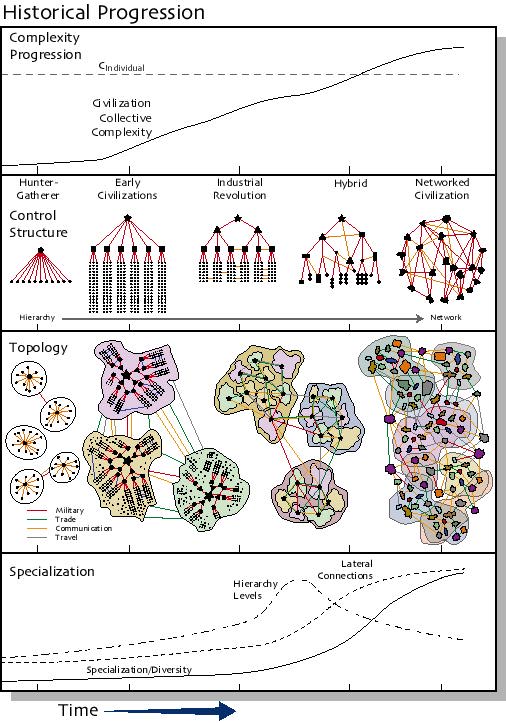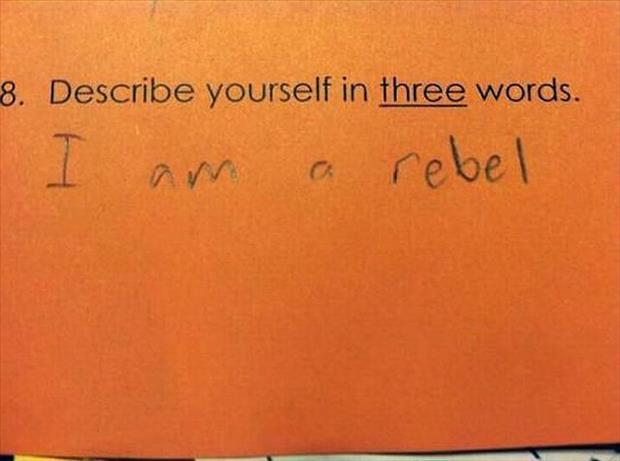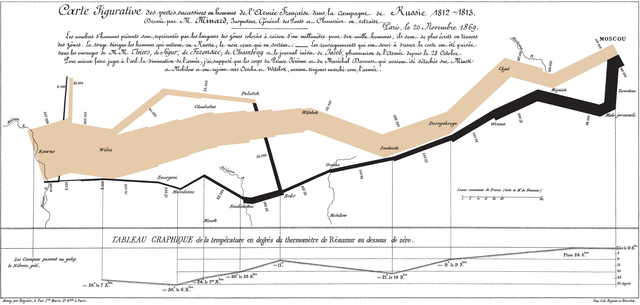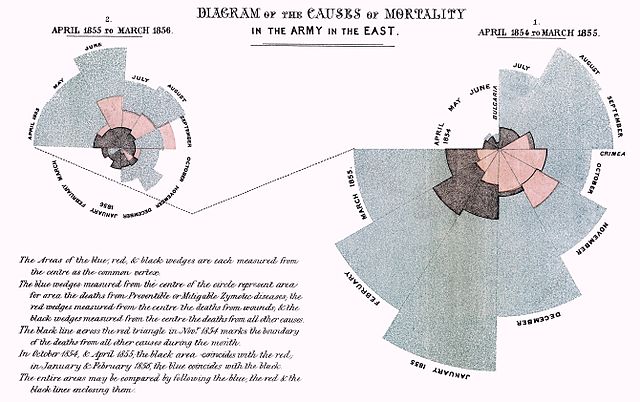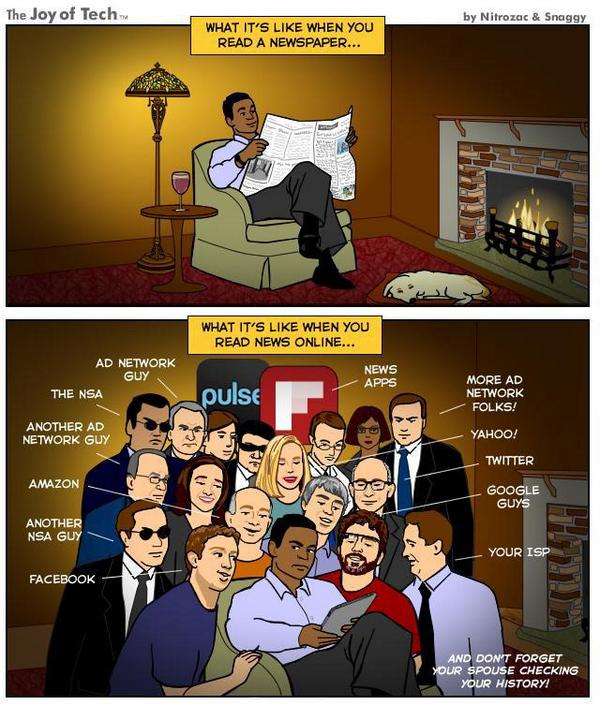Archive for the ‘English’ Category
Breast Cancer Screening: Benefits and Harms
Saturday, December 20th, 2014A picture is worth a thousand words, and this illustration from the JAMA will unfortunately never be displayed on giants billboards as advertising in favor of breast cancer screening keeps on being.
When to Use JPEG, GIF and PNG
Thursday, December 18th, 2014From WhoIsHostingThis
All products are conversations
Wednesday, December 17th, 2014People who work at Walmart talk about hating Walmart.
People who work at Starbucks talk about the day to day of customer service. Difficult customers, that kind of thing.
Big difference.
Nowadays, people talk a lot. On a multitude of channels. From blogs to big papers and everything in between.
Unless you have an army of publicists, you’re going to have trouble managing that conversation.
Much better to give them something great to talk about.
Control the conversation, by starting it in the right place.
Text and cartoon by @gapingvoidart
The Collaboration Pyramid revisited
Monday, December 8th, 2014In a great blog post, Oscar Berg (@oscarberg) revisited the collaboration pyramid by showing the social immersed part of the iceberg that allows collaboration processes to come true.
Oscar Berg’s greatly valuable contribution is to state that all these "under the water" processes can remain implicit when a team meets in real life, but, as deep foundations, must be explicitly addressed when social activities are operated through electronic media.
Complexity Rising: From Human Beings to Human Civilization
Monday, November 24th, 2014Could you believe that this plainly modern picture illustrates a paper by Yaneer Bar-Yam published in 1997?
Rebel
Monday, November 17th, 2014Rosetta and Philae: Waiting for confirmation of landing
Wednesday, November 12th, 2014ESA official website displays "Waiting for confirmation of landing. Expected at around 16:00 UTC"
Meanwhile, with XKCD, we just can guess the way it goes up there…
Franck Cammas and the Flying Phantom in Saint Malo
Wednesday, November 12th, 2014Far less glamorous than the superb video featuring the waterski champion Claire-Lise Welter, but more grounded in reality, Franck Cammas tested the Flying Phantom Phantom in front of Saint Malo.
The weekend of the start of the 10th Route du Rhum, was a good opportunity for the French skipper and the 2010 edition winner, to test the production version of the Flying Phantom as he collaborated to the development of the R&D prototype with the Groupama Sailing Team.
Franck Cammas and the Flying Phantom in Saint Malo from Jeremie Eloy/ Wanaii Films on Vimeo.
The Zeitgeist in health, the media and the public
Tuesday, November 11th, 2014In a paper published today, David Oliver answers a complex question "The media narrative on quality in healthcare—helpful or harmful?"
I found the last two chapters really insightful:
Finally, as someone who is part of the health policy "commentariat" and clinical leadership community, I am struck by the mismatch between some of the zeitgeisty groupthink in those echelons and the priorities in the news media. Everyone is talking about "asset based approaches," "developing community resilience," "prevention," "integration," "care closer to home" with "new models outside hospital," "supported self care," "personalisation," "activist patients," "personal budgets," and "person held records." All this magic thinking comes from a select group of self styled innovators and thinkers, and a small empowered group of largely middle class, educated service users. I am not saying any of these priorities are wrong, but it’s like a small policy elite is trying to dictate to the wider public what its priorities ought to be.
Out there in the press and the opinion polls, the public still use and want the reassuring old fashioned terms of "doctor" and "patient." They still have confidence in buildings (their local hospital or GP surgery) and basically want the care from those organisations to be caring, responsive, and accessible. The media haven’t caught up with the zeitgeist and neither have the public. But who’s to say they are wrong?
David Oliver is the president of the British Geriatrics Society, a consultant geriatrician at the Royal Berkshire Hospital, and a senior visiting fellow at the King’s Fund.
Innovative information visualization of electronic health record data
Tuesday, November 11th, 2014In a recent paper, Vivian L West, David Borland and W Ed Hammond investigated the use of visualization techniques reported between 1996 and 2013 and, in a systematic review, evaluated innovative approaches to information visualization of electronic health record (EHR) data for knowledge discovery.
The only embedded charts appear in the Historical Background chapter, and are related to the visualization of casualties during wars. I found them amazingly complex and modern.
A flow diagram by Charles Minard
The first is a figurative chart of the successive losses in men by the French army in the Russian campaign 1812–1813, published in 1869 by Charles Minard.
It looks like a curve, but actually draws a geographical path, naming towns and rivers. The brown (initially red) line represents the way from the Russian border to Moscow and the black line the way back. The broadness of the trait represents the number of men involved (1 mm for ten thousand men in the original document). It is clearly visible that few escaped.
This drawing by Minard is one of the most famous example of a specific type of flow diagram, now called Sankey diagrams, in which the width of the arrows is shown proportionally to the flow quantity.
Under the geographic path, a curve shows temperatures during the way back, expressed in Réaumur scale.
A polar area diagram by Florence Nightingale
The second example is the "Diagram of the causes of mortality in the army in the East" by Florence Nightingale.
Nightingale is described as a true pioneer in the graphical representation of statistics, and is credited with developing a form of the pie chart now known as the polar area diagram, or occasionally the Nightingale rose diagram.
This graphic was published in Notes on Matters Affecting the Health, Efficiency, and Hospital Administration of the British Army and sent to Queen Victoria in 1858. It indicates the number of deaths that occurred from preventable diseases (in blue), those that were the results of wounds (in red), and those due to other causes (in black).
A Proposed Invention Cycle
Sunday, November 9th, 2014Yesterday, Nilofer Merchant pointed out a great article by the title "Inventing Products is Less Valuable Than Inventing Ideas".
This article mainly elaborates from a paper called "The Second Face of Appropriability: Generative Appropriability and Its Determinants", by Gautam Ahuja (University of Michigan), Curba Morris Lampert (Florida International University) and Elena Novelli (City University London). Appropriability is defined here as "how firms can appropriate value from their inventions" and authors state that "scholars have focused on the idea that inventions create value for firms by being translated into products or by being licensed out" just before they introduce their true scope:
However, from the time of Arrow (1962), and possibly earlier, researchers have recognized that there are usually at least two facets to any invention. On the one hand, an invention is a solution to some technoeconomic problem, a source of enhanced utility or lower cost for some set of beneficiaries; on the other hand, an invention is a concept, an idea that adds to our universe of concepts and ideas and that can itself become a seed for future concepts and ideas. Thus, Arrow’s (1962) abstraction suggests that any invention potentially creates two types of value: an intrinsic value that relates to the problem-solving aspect of the invention and a fecundity, or generative, value that relates to its potential as a springboard for future inventions (Hopenhayn & Mitchell, 1999).
Appropriability hence comes in two flavors: how to capture the greatest share of profits from the problem-solving invention, called Primary Appropriability (PA) and how to capture the greatest share of future inventions that are spawned by this invention and thereby benefit from the new element it has added to the universe of ideas, called Secondary or Generative Appropriability (GA).
The paper mainly focuses on the best strategies for big organizations (firms) to benefit from GA, which, while culturally of interest, is not my primary topic. GA is nevertheless a plainly consistent concept in my favorite topics: lean startups and meshed society.
To invent in a meshed society means understanding what new services are needed by networked individuals. If we agree with Antoine de Saint-Exupery that "illumination is no more than the Spirit’s sudden vision of a road that is long prepared," inventions will probably happen in a meshed society from individuals that can establish a wide social network and gain enough hindsight from these rich interactions. Nilofer Merchant is very talented to describe this ongoing process.
What the text from Ahuja, Lampert and Novelli points out is that neither this invention, nor the service(s) built from it, should be the final goal. Considering that Generative Appropriability is more important than Primary Appropriability, they suggest that invention should be the starting point of a cycle invention – services – invention… Fortunately it is perfectly consistent with the way modern services are built and it is possible to describe this cycle in pretty accurate details.
The Product
The first step could be called a "rush to the minimum viable product (MVP)". The usual way to do is to pack the very core of the invention into a true usable product. MVP should never mean half-done, but a full designed and functional product that operates only the critical functions (typically five functions). Lean and mean!
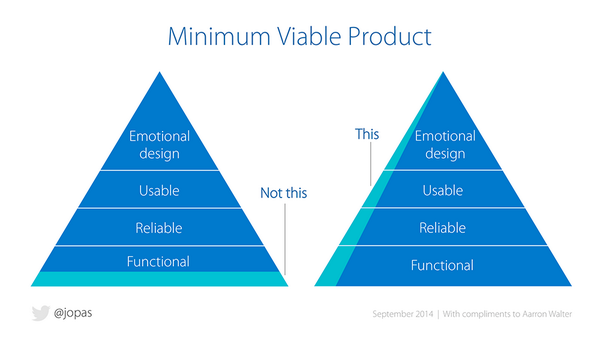
Credit Jussi Pasanen (@jopas)
Emergency here comes from a model where things are going so fast on the web that, like when sweating on a running mill, standing still means going backward. Accordingly, being settled on your invention while trying to optimize its Primary Appropriability (for example when writing a business plan to raise lots of money in order to hire a large team to target a fully functional 100+ functions product) means loosing ground and taking high risk that your massive footprint product will not find any place in several years later landscape. My own words, when I estimate that the product comes too late after the invention and we are no longer inventing while not still able to learn from our customers, is "we are starting getting stupid" (typically losing our time implementing functions that people may never use).
Hence the lean startup movement and its foundation principles: deliver early and often (usually thanks to Agile methodologies), engage with your users so you can learn from them (and pivot if necessary), measure success metric so that you can fail fast (so you can succeed faster).
Meshed Society
Great, but these principles are valid in the web as it goes, where kids are taught they can change the world by creating the services they themselves find cool (for example what girls are available on the campus) and pivoting endlessly until they become Facebook. As previously mentioned, in a meshed society, most inventions will be born from the network and, if the lean principles mainly apply, they will fade out in the specific way a meshed society operates; instead of "gaining users and engaging them", inventors will seamlessly offer the societal network a new service. To "make a dent in the world", as Nilofer Merchant usually phrases it, will no longer mean creating a mogul company to "rule them all" but truly raising the meshed society one step further.
To get the point here demands a little more accuracy about what meshed society actually means. To make it short, there is growing evidence that we already entered the post-industrial era and that the very root our societies are built from must be questioned.
From early times in human life, we inherited the hierarchy, as many other animal species did. Hierarchy for human has been meritocratic (the Dominant Male), then hereditary (some got stuck there) or elective. Jeremy Rifkin, in The Third Industrial Revolution explains that the pyramidal hierarchy became the way to go in the industry during the first Industrial Revolution when railways giants became the first private organizations to need thousands of employees to operate. For centuries, it has been delusive (or poetic) to imagine other ways to organize.
The web as we know it is probably a vector of change that only compares in history to the invention of the printing press… but it compares with the printing press "power thousand" since it is not just a communication system, but an operating system, a place where information can not only get published, but also processed.
We all know the recent history of the web, from a place where official and institutional information was available to the place where people co-create – the famous Web 2.0 coined by Tim O’Reilly. Many have tried to imagine the next web – due to a complete lack of creativity they usually called it Web 3.0. Web 3.0 would either be a semantic web or the web of objects (WoO) or web of things (WoT); they forgot that, as quoted by Jean Bodin, "there is no wealth nor strength except in men" and the next web can’t be anything but the operating system of a new kind of democracy. What is to come is not a technical Web 3.0 but a humanistic Meshed Society; a worldwide bionic neural network born from the ability to build knowledge from shared information.
When discussing Generative Appropriability (GA) versus Primary Appropriability (PA), it is of great interest to compare Xerox with Apple, stating, as Ahuja et al. did, that the former "has created many inventions but has not necessarily been successful in building on many of them" while the later "is an example of a firm that has managed to be creative in both building on its own inventions (e.g., the iPhone and iPad based on the iPod) and in precluding (or at least delaying) other companies from successfully building on its ideas." It is probably of utmost interest to foresee how it can get transcribed in the meshed society core concepts, in the wisdom of crowds.
The cycle
Let’s go back to the invention – product – invention cycle.
We know that inventions will happen from using the network to be able to "rise above to crowd" and gain the proper hindsight. We also suggested that a minimum viable product should quickly follow the invention in order to reward the network with a new service. Then ideally iterate, somewhat like a respiration process. But this mechanism is not generative by itself! On the contrary, the aim of the MVP in the lean startup theory is to build a light object in order to make it easier to find the place where it can fit in the current universe of services, then to iterate to grow step by step, and eventually pivot when there is no place left for a larger object in the previously targeted direction. If the product can seamlessly follow the invention, it is not natural at all to have a new invention be born from it.
It follows that our cycle will hardly be a two stroke engine! But after all, the most famous continual improvement cycle, the Deming Wheel is a four stroke engine, and we can probably mix its Plan-Do-Check-Act (PDCA) iteration steps with the lean startup concepts. Since our core principles are that, in a meshed society, invention will come from engaging with the network then (remembering Saint-Exupery’s quote) have illumination emerge from processing the flow of interactions using a synthesis oriented reactor (say a creative human brain), we can now name the missing strokes and end up proposing an Engage-Process-Invent-Build cycle.
To be continued… after some more interactions. Please let me know your opinion.
Added (on November 12), this drawing from a previous post (Responsive Organizations) that pretty well fits in the landscape, even if not explicitly cyclic (it is indeed!).
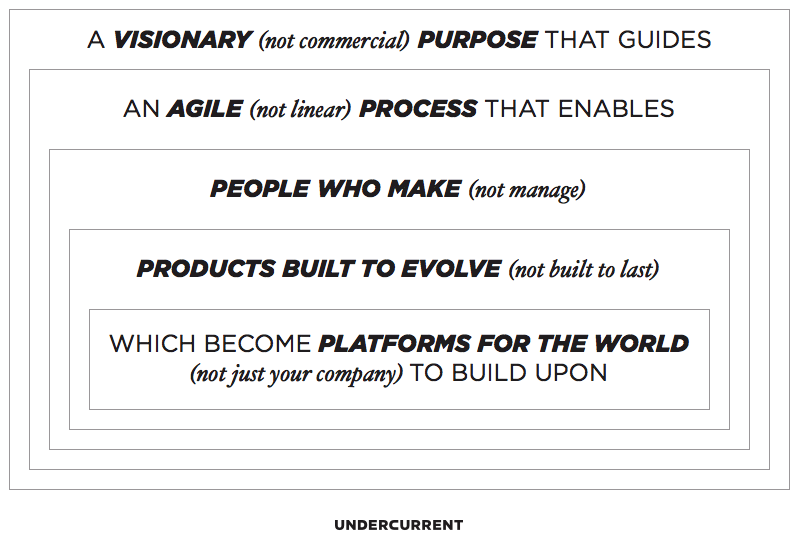
What it’s like when you read
Wednesday, November 5th, 2014Change management is an unfortunate field
Wednesday, October 29th, 2014Change management is an unfortunate field that is more aptly described as "change enforcement." It comes from the control mindset, where your job is to make other people do what you want (but what they might not want). Change is more than that, and in human organizations, change is not viewed as something you enforce. Yes, sometimes part of change requires people to do new things – things they may not want to do initially. But the methods for getting that to happen acknowledge that change is something that emerges and is connected to growth and development of everyone in the system, including the ones who might be resistant to the change.
A text from Humanize by Jamie Notter & Maddie Grant, cited by Richard Martin
Frame of reference
Saturday, October 18th, 2014A traveler, by definition, moves around the universe—that, at least, is the Copernican view we believe in to begin with. But as we travel around the world, we discover that just the opposite is true, that we are in fact the center of our own universe, as the ancient cosmogony would have it.
Travelers stay put, with their personal tunes, their mobile computers, their phones that store cherished data, their friends in their heads and their pianos in their bellies, as the Henri Tachan song goes. Travelers remain at the center of the world, while the whole world moves and revolves around them, as in one of Hayao Miyazaki’s animated films.
Travel is not about rushing to reach some goal or refuge. It’s about stopping to take in the changing surroundings, like a stormy sky. It’s about folding up your umbrella and letting the rain fall on your soul, as on a house without a roof.
But it is also about creating situations ripe for adventure, full of shifting viewpoints, relativity-style, full of fruitful, if random, moments, as in quantum mechanics.
To read a book, listen to a concerto or decode a mathematical proof is to embark on a journey; but to undertake a journey is to write a book with one’s actions and words.
Just choose (or not) a time and a destination and you have an outline of the subject and the main sections. Next come the chapters, with their twists, anecdotes and details that make it all true to life. You are in constant dialogue with your surroundings throughout the journey, adapting the plot, improvising, eliminating a protagonist you’ve grown tired of, as in a Conan Doyle novel.
The journey that takes form through an interplay of design and random chance is the novel the writer has to write, the cri du poète, as in a verse by Louis Aragon.
You feel soothed after the journey, a few cris lighter and enriched by the stars encountered along the way, as in one of Edmond Baudoin’s graphic novels.
Cédric Villani, French Mathematician, 2010 Fields Medal laureate
Happiness innovates
Saturday, October 11th, 2014Text and cartoon by @gapingvoidart
Drones Choreography
Wednesday, September 24th, 2014Cirque du Soleil, ETH Zurich, and Verity Studios have partnered to develop a short film featuring 10 quadcopters in a flying dance performance. The collaboration resulted in a unique, interactive choreography where humans and drones move in sync.
Precise computer control allows for a large performance and movement vocabulary of the quadcopters and opens the door to many more applications in the future. More on this on Flying Machine Arena website.
Science Fiction Spaceships
Tuesday, September 23rd, 2014This size comparison of sci-fi spaceships is totally useless… unless some of them are already flying in your head or in your dreams!.
Foiling in love
Tuesday, September 16th, 2014"Foiling in love" is the signature of the Great Cup GC32 One Design Multihull.
Four GC32 have been competing during latest Marseille One Design, and it is really exhilarating to see them fly.
© François Déliac – Icarus – The Great Cup
Sebastien Rogues and his GDF Suez crew would have won the race had it not been for a rudder breakage on the opening day that forced them to count two ‘DNSes’ in their scoreline. Congratulations to the winners, Flavio Marazzi and his Armin Strom Sailing Team crew.
Innovation versus Creativity
Wednesday, September 10th, 2014They’re synonyms. But companies shut their creatives up in a room together. And then ask the rest of the company to innovate.
This rarely works. Creativity can’t be bottled. Only guided gently in the right direction.
One quote that sums it up neatly, from a speech by John Emmerling: "Innovation is creativity with a job to do."
(Creativity is innovation when it’s off the clock.)
Text and cartoon by @gapingvoidart

